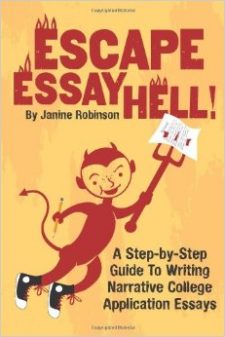College Admissions Essays
How to Write an Anecdote
For Your College Application Essay, Personal Statement or other Essays
If you can write an anecdote, you can write a powerful essay.
But a lot of students don’t know what an anecdote is, let alone how to write one.
It’s really just a weird word for a little story or animated description of something that happened.
Usually they are very short.
If done well, they make excellent introductions for all essays since they grab the reader’s attention.
In essays, an anecdote is an example of a point you want to make that uses a little story or animated description.
Example: You want to make the point in your essay that you are a creative person.
So you write an anecdote to illustrate your point: You could describe something creative that you made, or you could describe yourself making something interesting.
Like this:
During a walk near my home, I found a long stick that looked like the letter “Y.” I smoothed the surface with sandpaper and covered it with blueberry blue paint I found in the garage, then wrapped it with twine and colored yarn. From my junk drawer, I tied seashells, a couple old keys and a bent fork to the ends and hung it in my room.
“What’s that?” my little sister asked.
“Art,” I said, even though I wasn’t even sure what I had made.
(Then background your interest in art, how you think about it, why you value it, how it has affected you, changed you, and what your plans are for it in the future…)

Writers often start essays with an anecdote as a way to illustrate their point.
In a way, it’s like showing a photograph or picture along with the information.
Anecdotes create pictures—or a small snippet of video—using words. The writer wants you to see their point for yourself, rather than explain it to you.
That’s why it’s important to include details to help the reader see what’s happening.
What does it look like?
What does it feel like?
What do you hear (does someone say something?)?
In the anecdote above, the writer shows you how she or he is creative with the example of making the mobile out of a stick. Note that the writer does not start by explaining or telling you that she or he is creative. The explanation can come later.
What introduction would grab your attention better in an essay?
1. (Telling or Explaining) I am a very creative person, and I always use my imagination to make cool things. Sometimes I collect found objects, such as sticks and old trinkets, and turn them into mobiles. My sisters think they are strange, but to me they are art.
2. (Showing) During a walk near my home, I found a long stick that looked like the letter “Y.” I smoothed the surface with sandpaper …

Another key piece of a powerful anecdote (as with all stories) is some form of adversity. This can take many forms: a challenge, an obstacle, a problem, a conflict, a personal hang-up, a syndrome, an accident, etc.
RELATED: My Video Tutorial on How to Write an Anecdote: Part One
They can be very subtle.
In the example above, the adversity was in the form of a challenge—making something interesting out of a stick. Find a juicy problem in my Jumpstart Guide.
In your college admissions essay, if you want to make a point about the kind of person you are, just substitute that quality or your main characteristics for “creative person” in the example above.
You can be disciplined, ambitious, focused, unique, flexible, a leader, supportive, loyal, shy, funny, etc…..In your essay, of course, you want to develop points about why your qualities matter.
Click HERE to find your defining qualities.
Ten Steps to Writing a Powerful Anecdote
For College Application Essays, Personal Statements or Other Essays
To write a strong anecdote, you need to:
1. Know what you are trying to show or illustrate (by example) with your anecdote.
2. Include some type of adversity, problem, conflict, obstacle (if you want a powerful little story)
3. Start at the peak of the action in the moment.
4. Make sure something happens. It might take no longer than a few minutes.
5. Include details to create a visual image. Set the scene with the 5Ws (who, what, when, where and why.)
6. Keep it short. Start long, then cut it down to the fewest words necessary.
7. Save the background for the next paragraph or later
8. Don’t explain too much; save that for later.
9. Use more verbs and nouns than adjectives and adverbs.
10. Stick with shorter sentences. Include a snippet of dialogue.
These take practice.
But once you use them, you have crossed over from producing dry, formal English papers to real, descriptive writing! Anecdotes are one of the most powerful writing tools.
They are perfect for college admissions essays—especially introductions—but you can use them in almost all writing to make it more interesting.
Are You a Visual Learner? My Video Tutorial on How to Write an Anecdote: Part One
Here’s another post I wrote earlier about how to write an anecdote.
I just wrote yet another post on how to turn a seemingly small, mundane event or incident into an anecdote.
See how much I want you to learn how to use these?
My Crash Course in How to Write an Anecdote Contains
All My Posts on Anecdote Writing!
Thanks!








Your tips are extremely helpful and I enjoyed reading your article on anecdotes. I came across this while trying to help my son jumpstart his essay and it gave him a great idea for his introductory paragraph.
Thanks!
Karen